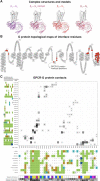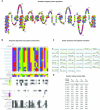The G protein database, GproteinDb
- PMID: 34570219
- PMCID: PMC8728128
- DOI: 10.1093/nar/gkab852
The G protein database, GproteinDb
Abstract
Two-thirds of signaling substances, several sensory stimuli and over one-third of drugs act via receptors coupling to G proteins. Here, we present an online platform for G protein research with reference data and tools for analysis, visualization and design of scientific studies across disciplines and areas. This platform may help translate new pharmacological, structural and genomic data into insights on G protein signaling vital for human physiology and medicine. The G protein database is accessible at https://gproteindb.org.
© The Author(s) 2021. Published by Oxford University Press on behalf of Nucleic Acids Research.
Figures



References
-
- Avet C., Mancini A., Breton B., Le Gouill C., Hauser A.S., Normand C., Kobayashi H., Gross F., Hogue M., Lukasheva V.et al. .. Effector membrane translocation biosensors reveal G protein and B-arrestin profiles of 100 therapeutically relevant GPCRs. 2020; bioRxiv doi:24 April 2020, preprint: not peer reviewed10.1101/2020.04.20.052027. - DOI - PMC - PubMed
Publication types
MeSH terms
Substances
LinkOut - more resources
Full Text Sources
Other Literature Sources

